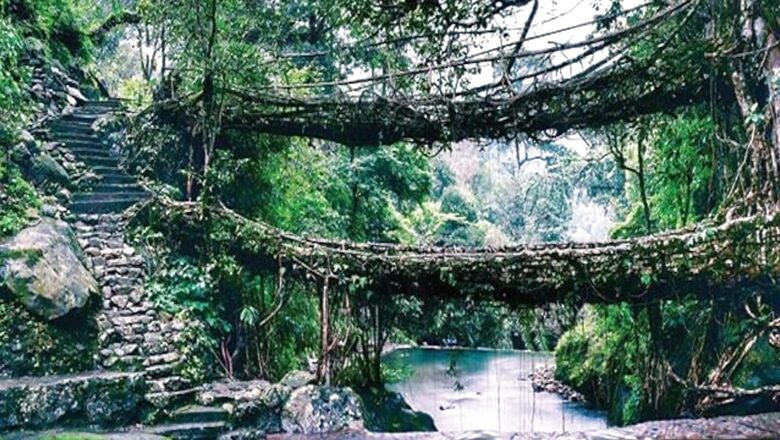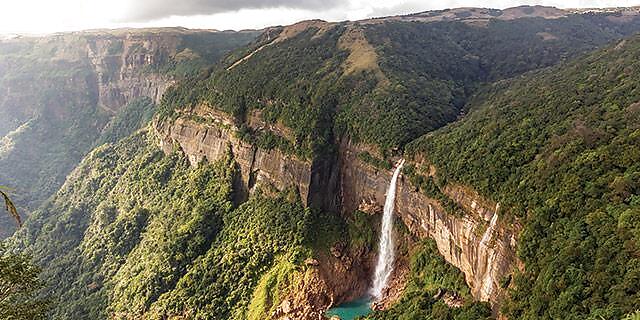
views
These bridges have helped the indigenous Khasi and Jaintia communities to cross swollen rivers in monsoons for as long as they can remember.
Think of a dense forest with majestic trees whose roots have intertwined to form a bridge across a gushing river… Did you think of magic? Of nature spirits and elves who can shape trees by singing to them? Or did you think of JRR Tolkien’s Ents – the majestic trees who could move and talk (and also destroy Saruman’s tower!)? Maybe you thought of JK Rowling’s Whomping Willow on the Hogwarts campus – the temperamental tree who could be counted on to “whomp” anyone who got too close! Chances are, whoever you thought of was dreamed up by its creator to represent the awesome power of nature, and its ability to protect and heal.
Living root bridges made of intertwined roots are a sort of magic, but they aren’t imaginary.
Meet the Living Root Bridges of Meghalaya.
These bridges have helped the indigenous Khasi and Jaintia communities to cross swollen rivers in monsoons for as long as they can remember. There are no written histories of how and when the first root bridges were built, but scientists believe that some have stood strong for centuries. You’ll never forget your first Living Root Bridge. There’s nothing like it. Each structure is a little ecosystem – full of life and the living. Each represents how beautiful a harmonious meeting of man and nature can be.
How are they grown?
Building these bridges is a labour of love that spans decades. First, a suitable location is identified along the riverbank and a sampling of the Ficus Elastica, the rubber fig tree, is planted. This tree is special as its roots are elastic enough to allow weaving. It takes about a decade for the tree to grow and form large buttressing roots and then another decade for the maturing trees to grow secondary aerial roots that can be woven to form stable structures.
In a method perfected over centuries, the Khasi bridge builders weave the aerial roots onto a bamboo scaffolding, and then gently nudge these roots across the river and ultimately implant them on the opposite bank. Every two years, they change the bamboo scaffolding because the damp and humid conditions can cause the bamboo to rot. Over time, the roots thicken and intertwine with another rubber tree on the other side. They merge by a process called anastomosis – where branching systems like leaf vessels, tendrils and aerial roots naturally fuse together – and weave into a dense frame-like structure. This network of roots matures over time to create these marvels of natural bioengineering: some bridges can carry up to 50 people at once!
On average, these bridges grow anywhere between 50 – 100 feet. The longest known living root bridge, however, spans 175 feet and is located near Mawkyrnot of East Khasi Hills district.
Bridging Generations

Just like with children, it takes a village to raise these bridges! Each bridge requires a collective effort of an entire community to monitor, grow and maintain them. It also takes more than one generation to work on them. The young bridges being tended to today will carry the descendants of the people who are lovingly tending to them. In this way, each bridge is a gift for the future of the community. The Meghalayan culture of stewardship and conservation is what you see here: each generation creates something beautiful for the generations to come to use and enjoy and love.
Of course, human families aren’t the only ones who love these bridges.
Each bridge is Animal Approved!
Fig trees are great for biodiversity: moss grows on them, squirrels live in their branches, birds’ nests within their canopy, and they support insects that help with pollination. By engineering these trees into bridges, the Khasi have succeeded in creating several green corridors – places where animals can safely cross rivers. Bark deer and clouded leopards are known to use root bridges to move from one part of the forest to another. These bridges aren’t just a part of the landscape, they function to support and grow the ecosystem around them.
The future of living root bridges
Unlike conventional bridges that stand out from their environment, root bridges blend in. Apart from producing their own building material, the trees absorb the greenhouse gas carbon dioxide over their lifetimes. They help stabilize the soil and prevent soil erosion and landslides – a critical factor for rivers that absorb Meghalayan monsoons! Being a regenerative form of architecture, living root bridges grow stronger with time, self-repairing and becoming more robust as they age. Not only do the bridges provide connectivity and attract tourists which helps local people earn an income, but they also have regenerative effects on the surrounding environment. Could they be the answer to some of the problems climate change poses?
The resurgence of interest in root bridges can be attributed, at least in part, to the efforts of Morningstar Khongthaw, and his team who founded the Living Bridge Foundation. Morningstar and his team repair and maintain old living bridges and help construct new ones. They are even constructing classrooms to educate locals and conduct workshops on how to build these bridges. Of course, these classrooms are built on treetops! (Where else?) Besides bridges, the team is also building ladders, swings, seating platforms and even tunnels – stunning living architecture that showcases the possibilities of growing our structures, rather than making them.
Western researchers believe that living architecture can contribute to green cover in cities: integrating trees in buildings, bridges, and parks helps bring nature into otherwise bare and barren areas. Architects and researchers are looking to borrow elements from these bridges with a view to adapting them to urban environments. In fact, an experiment is underway, to create canopies with the London plane tree. The roots of the tree will be moulded into chairs as they grow. Exciting times! While you can wait for these experiments to take root in your city, it’s unlikely you’ll live to see it mature.
Alternative: Come see the originals in Meghalaya!
How to get there and what to keep in mind
If you’ve never been to Meghalaya, there’s never been a better time to visit. The state is celebrating its 50th year of statehood, and it’s basically a year-long celebration with experiences to attract every sort of traveller. Make a plan. See the living room bridges, walk through a sacred grove, eat local cuisine, attend a rock concert, swim in a crystal-clear river, or explore the wonder of caves that thrill scientists and adventurers alike. Make a plan. There’s something here for you.
It is the Meghalayan Age, after all.
This is a partnered post.
Read all the Latest News here




















Comments
0 comment